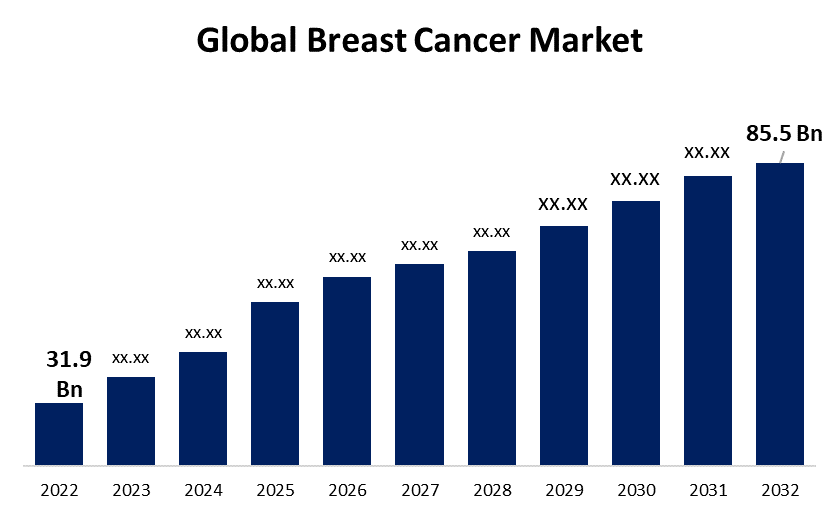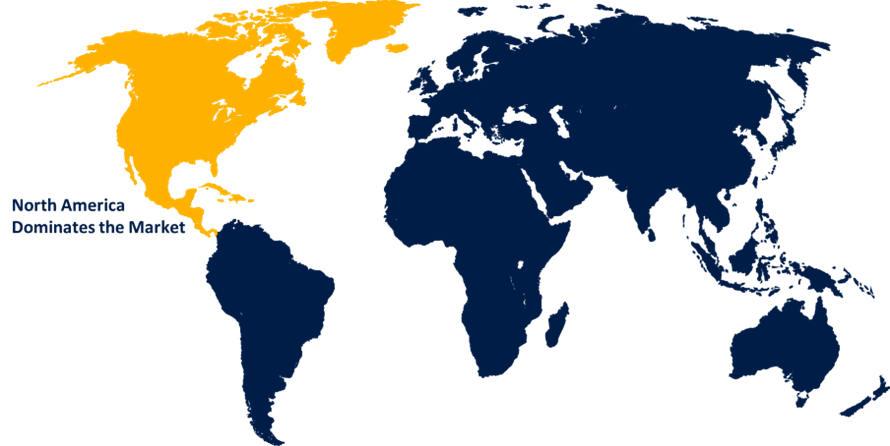Global Breast Cancer Market Size, Share, and COVID-19 Impact Analysis, By Cancer Type (Hormone Receptor, HER2+), By Therapy (Targeted Therapy, Hormonal Therapy, Surgery & Radiation Therapy, Biologic Therapy), By Distribution Channel (Hospital Pharmacies, Retail Pharmacies, Online Pharmacies, & Others), By Region (North America, Europe, Asia-Pacific, Latin America, Middle East, and Africa), Analysis and Forecast 2022 - 2032
Industry: HealthcareGlobal Breast Cancer Market Insights Forecasts to 2030
- The Global Breast Cancer Market Size was valued at USD 31.9 Billion in 2022.
- The Market is growing at a CAGR of 10.3% from 2022 to 2032.
- The Worldwide Breast Cancer Market size is expected to reach USD 85.5 Billion by 2032.
- Europe is expected to grow the fastest during the forecast period.

Get more details on this report -
The Global Breast Cancer Market Size is expected to reach USD 85.5 Billion by 2032, at a CAGR of 10.3% during the forecast period 2022 to 2032. Research and development in the field of breast cancer have expanded as a consequence of increasing demand from the medical sector for treating patients with new drugs and technology, which has greatly aided in the growth of the breast cancer market.
Market Overview
The most prevalent disease in the population is breast cancer, which mostly impacts women with proliferative disorders. Typically, breast tissues are where breast cancer begins. Lumps in the breast, changes in the size and form of the breasts, discharge from the nipples, and irritated, scaly red spots on the skin are all indications of breast cancer. Human epidermal growth factor receptor 2 (HER2) gene expression is associated with the development of breast cancer. The presence of this protein prolongs cell proliferation by stimulating cancer in the body. those with positive HER2 receptors have more aggressive breast cancer than those with other forms of breast cancer. Numerous treatments can be employed to cure and get rid of the tumor while raising the target on HER2. This expands the market for breast cancer by bringing in more patients each year & improving the long-term survival rate of the disease. Increased demand from the medical industry for treating patients with novel medicines and treatments is driving market expansion, thus it is important to expand research and development with more advanced technologies and therapies produced for treating breast cancer.
Report Coverage
This research report categorizes the global breast cancer market based on various segments and regions and forecasts revenue growth and analyses trends in each submarket. The report analyses the key growth drivers, opportunities, and challenges influencing the global breast cancer market. Recent market developments and competitive strategies such as expansion, product launch, and development, partnership, merger, and acquisition have been included to draw the competitive landscape in the market. The report strategically identifies and profiles the key market players and analyses their core competencies in each sub-segments of the global breast cancer market. Technological innovation and advancement will further optimize the performance of the product, enabling it to acquire a wider range of applications in the downstream market.
Global Breast Cancer Market Report Coverage
| Report Coverage | Details |
|---|---|
| Base Year: | 2022 |
| Market Size in 2022: | USD 31.9 Billion |
| Forecast Period: | 2022-2032 |
| Forecast Period CAGR 2022-2032 : | 10.3% |
| 2032 Value Projection: | USD 85.5 Billion |
| Historical Data for: | 2018-2021 |
| No. of Pages: | 180 |
| Tables, Charts & Figures: | 120 |
| Segments covered: | COVID-19 Impact Analysis |
| Companies covered:: | Bristol Myers Squiib, Kyowa Kirin, Eisai Co. Ltd, Sanofi, Pfizer Inc, Merck & Co, Novartis AG, Eli Lilly and Company, Genentech, Mylan Laboratories, Celltrion, Fresenius Kabi, Baxter Healthcare Corporation, Halozyme Inc·, GlaxoSmithKline,AstraZeneca |
| Pitfalls & Challenges: | COVID-19 Empact, Challenge, Future, Growth, & Analysis |
Get more details on this report -
Driving Factors
Breast cancer is the most common cancer among women globally, and its incidence is rising. This has led to an increased demand for breast cancer diagnosis and treatment, driving the growth of the global breast cancer market. Breast cancer incidence increases with age, and as the global population ages, the demand for breast cancer diagnosis and treatment is expected to rise, driving the growth of the global breast cancer market. Also, Advances in breast cancer screening and diagnostic technologies, such as mammography, ultrasound, and MRI, have improved the early detection and diagnosis of breast cancer. Similarly, improvements in treatment options, such as targeted therapies and immunotherapy, have led to better outcomes for breast cancer patients. In addition to funding programs for breast cancer screening, several governments throughout the world are also investing in breast cancer research and treatment and spreading awareness of the condition. As a result, there will be a greater need for breast cancer detection and treatment, which is driving the expansion of the worldwide breast cancer market.
Restraining Factors
Breast cancer treatment can be expensive, and the cost may be a barrier for some patients, particularly those in low- and middle-income countries. This can limit the adoption of advanced treatment options, such as targeted therapies and immunotherapy, and may impact the growth of the global breast cancer market. Moreover, limited access to healthcare facilities, particularly in low- and middle-income countries, can limit the early detection and diagnosis of breast cancer. This can impact the demand for breast cancer diagnosis and treatment and may limit the growth of the global breast cancer market. Some patients may prefer alternative treatment options, such as herbal medicines or traditional therapies, over conventional breast cancer treatment. This can limit the demand for breast cancer diagnosis and treatment and may impact the growth of the global breast cancer market.
Market Segmentation
- In 2022, the hormone receptor segment is dominating the market with the largest market share during the forecast period.
Based on the cancer type, the global breast cancer market is classified into hormone receptors & HER2+. Among these, the hormone receptor segment is projecting significant growth owing on an annual basis, there are increasing numbers of cases of breast cancer due to improved therapies and cutting-edge technologies.
- In 2022, the targeted therapy segment is influencing the largest market share over the forecast period.
The global breast cancer market is segmented into targeted therapy, hormonal therapy, surgery, radiation therapy, biological therapy, and others based on the type of treatment. During the projected period, the targeted therapy category will hold the greatest market share. due to the market for breast cancer being accelerated by increased therapy use as a result of higher output and improved performance from new drug introductions. Drugs used in targeted therapy such as Kadcyla, Afinitor, Lynparza, and Zortress. With recent regulatory approvals, immunotherapy has also gained a larger market share in the breast market.
- In 2022, the hospital pharmacies segment is driving market share growth during the forecast period.
On the basis of distribution channel, the global breast cancer market is segmented into hospital pharmacies, retail pharmacies, online pharmacies, & others. Among these, hospital pharmacies are expected to grow the market during the forecast period due to patients increased reliance on chemotherapy-related drugs. During the forecast period, the market for treatments for breast cancer is expected to rise as a result of rising patient demand for various pharmaceuticals and improved accessibility to such products in hospital pharmacies.
Regional Segment Analysis of the breast cancer market
- North America (U.S., Canada, Mexico)
- Europe (Germany, France, U.K., Italy, Spain, Rest of Europe)
- Asia-Pacific (China, Japan, India, Rest of APAC)
- South America (Brazil and the Rest of South America)
- The Middle East and Africa (UAE, South Africa, Rest of MEA)
North America is holding the market with the largest market share over the forecast period

Get more details on this report -
North America holds the largest market growth of the global breast cancer market due to the increased government initiative in developing novel medication developments, increased efficacy of the medications, and increased results help to enhance the market growth. Also, the advanced developed technologies in the market, in addition to an increased number of treatments available for treating breast cancer with an increasing number of patients, help to propel the market growth.
Europe region is projected to acquire the second-largest share in the global market premises, it can be attributed to the region's rising incidence of breast cancer and increased adoption of cutting-edge medicines.
Competitive Analysis
The report offers the appropriate analysis of the key organizations/companies involved within the global breast cancer market along with a comparative evaluation primarily based on their product offering, business overviews, geographic presence, enterprise strategies, segment market share, and SWOT analysis. The report also provides an elaborative analysis focusing on the current news and developments of the companies, which includes product development, innovations, joint ventures, partnerships, mergers & acquisitions, strategic alliances, and others. This allows for the evaluation of the overall competition within the market.
List of Key Companies
- Bristol Myers Squiib
- Kyowa Kirin
- Eisai Co. Ltd
- Sanofi
- Pfizer Inc
- Merck & Co
- Novartis AG
- Eli Lilly and Company
- Genentech
- Mylan Laboratories
- Celltrion
- Fresenius Kabi
- Baxter Healthcare Corporation
- Halozyme Inc
- GlaxoSmithKline
- AstraZeneca
Key Target Audience
- Market Players
- Investors
- End-users
- Government Authorities
- Consulting And Research Firm
- Venture capitalists
- Value-Added Resellers (VARs)
Recent Development
- In September 2022, in a cohort of patients with aggressive forms of hormone receptor-positive, human epidermal growth factor receptor-2 negative (HR+/HER2-) metastatic breast cancer, Novartis reported findings from a new pooled exploratory analysis across the entire MONALEESA Phase III study, indicating roughly an additional year of overall survival (OS) benefit (ABC).
- In August 2022, the US Food and Drug Administration approved the IV infusion Enhertu (fam-trastuzumab-deruxtecan-nxki) for the treatment of individuals with HER2-low breast cancer that is either metastatic or unresectable (cannot be removed). As a newly discovered subtype of HER2-negative breast cancer, this is one of the first therapies approved for patients with it.
Market Segment
This study forecasts revenue at global, regional, and country levels from 2022 to 2032. Spherical Insights has segmented the Global Breast Cancer Market based on the below-mentioned segments:
Global Breast Cancer Market, By Cancer Type
- Hormone Receptor
- HER2+
Global Breast Cancer Market, By Therapy
- Targeted Therapy
- Hormonal Therapy
- Surgery and Radiation Therapy
- Biologic Therapy
Global Breast Cancer Market, By Distribution Channel
- Hospital Pharmacies
- Retail Pharmacies
- Online Pharmacies
- Others
Breast Cancer Market, By Regional Analysis
- North America
- US
- Canada
- Mexico
- Europe
- Germany
- Uk
- France
- Italy
- Spain
- Russia
- Rest of Europe
- Asia Pacific
- China
- Japan
- India
- South Korea
- Australia
- Rest of Asia Pacific
- South America
- Brazil
- Argentina
- Rest of South America
- Middle East & Africa
- UAE
- Saudi Arabia
- Qatar
- South Africa
- Rest of Middle East & Africa
Need help to buy this report?